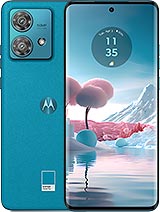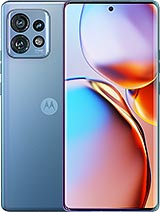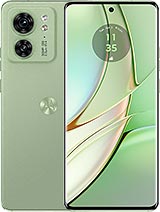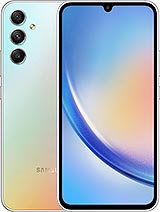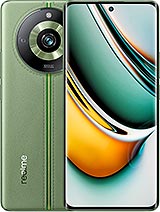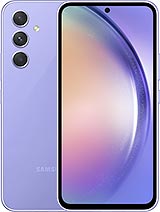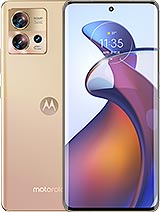Motorola Edge 40 Neo review

Extra smooth 6.55-inch OLED display
The Edge 40 Neo continues along Motorola's established path of offering higher display refresh rate than most of the competition and the number here is 144Hz. That leaves the Pro as the only member of the Edge 40 series at 165Hz, and by the looks of it, the Neo appears to be reusing the same panel as the vanilla model. It's got a 6.55-inch diagonal, and 1080p resolution. Motorola specifies HDR10+ support and a 360Hz maximum touch sampling rate.

The brightness we measured on the Edge 40 Neo places it on par with higher-tier Motos and in a leading position among potential competitors. The ambient-light-controlled boost reaches up to 1073nits while the manually attainable number is around half that, at 523nits. The minimum brightness of 2.8nits is also a solid result.
Color accuracy
Color reproduction on the Edge 40 Neo is handled in a familiarly simple way - There are just two modes plus a seven-position temperature slider for a little extra adjustment.
The default Saturated mode delivers a wide color gamut and overall very vivid colors, but we measured only so-so accuracy for DCI-P3 targets. As usual, the white point is the worst offender, alongside the grayscale patches, all of them having a bluish tint. As we've observed on some Motos in the past, if you bump the temperature slider towards warm, the color shift changes from blue to green and overall accuracy doesn't improve, while further action in the warm direction makes things progressively worse.
Natural mode, meanwhile, delivers good accuracy when displaying sRGB content, with only the faintest green tinge in the white and gray test swatches.
HDR and streaming
The Edge 40 Neo doesn't have a Dolby Vision certification like the Edge 40 Pro, but it is HDR10+-compliant like the lesser models in the lineup. YouTube says it serves HDR streams on the Neo, but they don't quite have the expected brightness boost until you switch them to fullscreen mode, at which point the display does liven up.
Netflix doesn't allow HDR playback on the Neo, and it may be a matter of the streaming service whitelisting the device at some point. The Widevine L1 certification does enable FullHD playback, which is nice.
Refresh rate
We've come to expect not just refresh rates that are higher than most from Motorola phones, but also a very straightforward software implementation of the feature - almost rudimentary, but at the same time honest. That's also the case on the Edge 40 Neo where there are three specific modes - 60Hz, 120Hz, and 144Hz, plus Auto. The three modes will each maintain the respective refresh rate with little regard for what's being displayed (with small exceptions) or whether you're interacting with the phone or not.

The Auto mode does introduce some auto switching. It will maintain 120Hz for the UI as long as you're touching the display and it will switch to 60Hz when idling. It will also use 90Hz liberally but won't go as high as 144Hz.
Browsers will maintain 120Hz when you're scrolling, but will otherwise drop to 60Hz. Video playback apps will default to 60Hz when displaying fullscreen videos, though a 90-60Hz switch is implemented for the UI outside of fullscreen playback.
Games are seemingly capped at 60Hz in Auto when they're set to the 'follow system' setting. You can set a higher refresh rate on a per-game basis, or pick one of the higher global settings from the display settings menu before gaming- it's just that the Auto isn't gaming-friendly.
Motorola Edge 40 Neo battery life
Despite the Edge 40 Neo's compactness, Motorola has managed to fit a 5,000mAh battery inside it, which is about as much as you can expect from a mainstream phone and essentially what every reasonable competitor is fitted with.
In our Active Use test, the Edge 40 Neo posted lower than average numbers in the gaming portion and was otherwise on par with the Galaxy A54 in the web browsing and video playback. The Realme 11 Pro and the Redmi Note 12 Pro are significantly better in all the screen-on disciplines, though.
Expand to reveal our legacy battery test (Endurance rating). How we test now.
In our testing, however, the Moto wasn't all too efficient with its power usage. While the standby turned out okayish and the voice call longevity was pretty good at 29h, the results in the screen-on tests were closer to what we'd label disappointing. Particularly bad is the 10:01h figure in web browsing, with the only consolation perhaps being the fact that it's carried out at a constant 144Hz. The 14:13h video playback number is a bit more acceptable, though still below average.
With everything dialed into the formula, the Edge 40 Neo's overall Endurance rating worked out to 80h.

Our battery tests were automated thanks to SmartViser, using its viSerDevice app. The endurance rating denotes how long the battery charge will last you if you use the device for an hour of telephony, web browsing, and video playback daily. More details can be found here.
Video test carried out in 60Hz refresh rate mode. Web browsing test done at the display's highest refresh rate whenever possible. Refer to the respective reviews for specifics. To adjust the endurance rating formula to match your own usage - check out our all-time battery test results chart.
Charging speed
You'll find a 68W adapter in the box of the Edge 40 Neo, which Motorola says should be able to get you from empty to 50% in 15 minutes. Indeed, that's the result we got from our unit, with the charging rate peaking at around 57W in the early stages of the process.

After keeping the phone plugged in for 30 minutes we were looking at 82% in the battery indicator, while a charge to 100% took us 51 minutes. The numbers make the Edge 40 Neo one of the fastest charging handsets for the money, particularly in the first minutes, which is what matters most, we'd say.
Those results were obtained with the Charge boost feature enabled in settings - otherwise, you'd be getting slightly slower speeds. That said, the difference isn't dramatic - we had 74% at the 30-minute mark and 54 minutes to 100%.
A relatively new feature on recent Motos that makes it to the Edge 40 Neo as well is the Overcharge protection toggle in the Battery menu. It will cut off charging once it detects that the phone hasn't been unplugged for three days straight and keep the battery charged at a much healthier 80%. Optimized charging is also there - that's the feature that only charges the phone to 80% and adds the final 20% just before you'll be needing the handset - it does need to learn your usage patterns first, of course.
There's no wireless charging on the Edge 40 Neo, while the 30 Neo did have that provision, if only just a basic 5W rating. That said, it's not really common in this price bracket anyway, so the previous model was more of an outlier.
Speaker test
Similarly to other models in the series, the Edge 40 Neo employs a conventional hybrid stereo speaker setup where the earpiece also works as an extra channel. It's assigned the left channel when the phone is held vertically, while in landscape the channels will be switched depending on the orientation - Motorola even makes a mention of this otherwise most logical behavior in the Dolby Atmos 'learn more' section. Each speaker gets its own channel only - there's no outsourcing of some (lower) frequencies from the earpiece to the 'main' speaker on the bottom.
Just like the Edge 40, the Neo's top speaker only outputs sound towards the front, so you won't be getting spillage from your voice calls like you would on the Edge 40 Pro.


Bottom speaker • Top speaker/earpiece
The phone earned a 'Very Good' rating for loudness in our test - an upgrade over the previous generation and on par with the Edge 40 proper, where the Neo even has a slight numerical advantage in the result. Competitors, meanwhile, are pretty much all a notch down into the 'Good' loudness tier.
The Edge 40 Neo sounds better to our ears than the Realme 11 Pro or the Redmi Note 10 Pro. The Galaxy A54 is a bit more bassy than the Neo, which is a good thing, and perhaps the only area where the Moto's otherwise very balanced output can use a bit of inprovement.
Use the Playback controls to listen to the phone sample recordings (best use headphones). We measure the average loudness of the speakers in LUFS. A lower absolute value means a louder sound. A look at the frequency response chart will tell you how far off the ideal "0db" flat line is the reproduction of the bass, treble, and mid frequencies. You can add more phones to compare how they differ. The scores and ratings are not comparable with our older loudspeaker test. Learn more about how we test here.
Reader comments
- Anoob
- 19 Jan 2025
- a4{
I am using motorola edge 40 neo for more than one year. I would say it is economic edge phone as compared to other Edge versions. Features are ok but sometime some hanging issues was there now its ok after software updates. Camera is decent. Built ...
- mental boulder
- 01 Nov 2024
- JKU
You didn't mention a single specific flaw. You wrote so much text, you just talk about how you were disappointed, what specifically were you disappointed in? I think you get paid to spit on products, I can't believe how bad it is. Look at...
- Anonymous
- 16 Sep 2024
- JcM
Eege 40 neo is a good phone. curved screen, 144 hz makes a decent feel..
